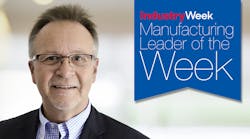When he spoke to IndustryWeek in June, Nigel Francis had spent all of 10 days as CEO of LIFT, the Detroit-based Manufacturing USA institute focused on lightweighting innovation. But Francis already had more than a passing familiarity with the place, having been part of the team that put together the proposal to bring the Institute to Michigan in the first place
Francis’s background is a fertile mix of engineering, R&D, automotive and economic development roles. “My sweet spot is at the intersection between general management, business development and advanced technology,” he says. He’s served as a vice president of advanced engineering and technology development at American Axle, vice president of vehicle engineering at Mercedes-Benz Technology, and senior automotive advisor to Michigan Gov. Rick Snyder.
Now that LIFT has a solid membership base (about half of its 200 members are manufacturers) Francis wants to build awareness around what the institute has to offer small and medium-sized manufacturers—“an incredibly important focus for us going forward. I’m acutely aware that the U.S. economy is driven by small- to medium-sized enterprises,” he says.
“They are the very enterprises innovation is likely to come from, but they also have small financial war chests to go after things and are less likely to be able to afford the capital equipment necessary to perform the prototyping and experiments to prove out their innovations.”
Francis talked with IndustryWeek about that strategy, research and workforce priorities, and whether he’s worried about ambitious federal goals for automotive fuel-efficiency ending up in the rearview mirror.
What do you want those small- to medium-sized manufacturing companies to know that they don’t already know about you guys?
We’re open for business, we’re friendly and approachable, we’re a bunch of engineers and business people just like them, and there’s an opportunity for us all to create a win-win together. It is our job to empower them to be better.
So you want them to reach out to you when they’re innovating something, hit a wall or don’t have the equipment they need to test something they’re working on?
That’s the perfect thing for them to do, and to that end, we aim to make ourselves openly accessible to everybody. And indeed, if somebody calls in and wants me, and if they call my desk phone it goes straight to my cellphone, which I keep in my pocket all the time. If anybody is having trouble and wishes to contact the institute, they can call me at (586) 489-1642.
Can you give an example of something LIFT has to offer that a company may not have itself?
Typically, a small- to medium-sized company is incredibly focused. So they’ve got a narrow bandwith, with deep knowledge in that bandwith. … When they’re innovating, they very rapidly move into an area of expertise where they’re no longer world-class. They see an opportunity, but they don’t have the bandwith or depth of knowledge in that area to actually explore it. And we do. Our institute, together with its membership base across academia and industry, has very broad and deep knowledge, and so we can offer what I call “mindshare.”
Innovation by definition is a lot of failure followed by, if you get it right, one or two real home runs, but you have to be prepared for failure. And you need to fail fast. The faster you fail, the faster you can move on to the next [idea], because you’re basically trying to generate an innovation that has a business case behind it. You want to not only minimize the amount of money you’re spending, if they’re going to fail, but you also need to pull off your valuable resources as quickly as possible and redeploy them on the next one.
The typical thing that a small to medium enterprise will do is, they’ll go down the path, and because they have a relatively limited bandwith in this vertical that is outside the box for them, they’d don’t fail fast. What they do is keep going down that path. So we can help with that process of discovery or due diligence and help them understand faster and cheaper.
Once they pass the initial stage and determine a project is worthwhile, then what?
The next thing is to work out whether you can actually make a profit out of offering this product. And to work that out, you need to manufacture it. You need to prototype it to work out the cost and complexity of manufacturing … We have the capabilities within the Institute to do virtual testing, which would be computer-aided modeling and engineering, and also to manufacture and test physically.
Are there certain lightweighting technologies that are going to be your priority as leader? And do you think there’s any underknown technology that needs more R&D resources?
There are three or four that are looking incredibly important for us to focus and reinforce our activities going forward: thermomechnical processing, agile processing, joining and assembly. And there’s ICME—integrated computation materials engineering, which is basically microscopic modeling of material that more accurately characterizes the behavior of the material as it’s being used in its intended role.
There’s a first-order connection between this evolving area of microscopic modeling and the macroscopic modeling that is already being used by industry. It will drive lighter-weight structures, components and systems. Just because it will drive less material.
We live in a world where, probably 50 years ago there was a finite number of materials.Today, there is an infinite number of materials … Materials engineering today is just like cooking. Open up the cupboard and if you want you can put a little bit of everything in and cook it up or freeze it or just stir it around. And then taste it and see what it’s like. The good chefs are able to produce new flavors and new tastes.
There’s been a push by the current presidential administration to rollback the 2025 automotive emission targets. Do you see reduced federal interest in fuel-efficiency having any impact on LIFT?
The lighter it is, the less energy it needs to move and speed up or slow down. And less energy has at least a couple of implications. One of them is less emissions. The other is less cost. The federal government will do what it does in relation to emissions. Regardless, our Institute has an important and relevant role going forward because everybody is interested in saving money. Using less fuel means less cost.
Are there any strategical changes you would make if the CAFÉ (Corporate Average Fuel Economy) standards are rolled back?
I don’t think there is any change. Look, our membership is not just automotive by any means. Mass is criticially important in aerospace and space, and of course we’re funded through the Office of Naval Research, which is part of the U.S. Department of Defense, so we’re working on technologies that will enable the Defense Department to be more efficient in terms of their utilization of fossil fuels through lightweighting.
What are your priorities as far as workforce initiatives?
We all need to be coalescing to fix problems that are sneaking up on us real fast. One of the problems is if you look at the demographics of the workforce, a very large percentage is getting close to retirement, and there’s a gap behind them. One of the initiatives in my mind is to actually encourage Baby Boomers to stay in the workforce. … In Europe, it’s quite commonplace. People toward the end of their career buddy up with a second person [at the beginning of their career], and two people do one job. You transition into retirement.





